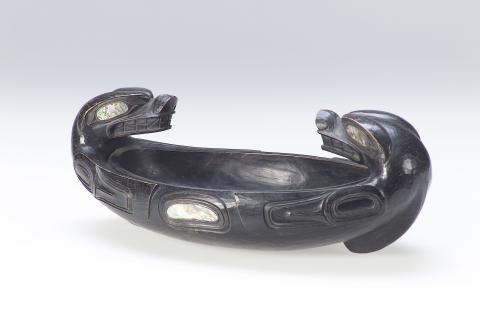Killer Whale Bowl
This is a bowl carved by Hoonah artist Lincoln Wallace, depicting killer whales.
Seal oil was normally served with meals so specially carved bowls were made to serve the oil in. Lincoln’s outstanding design gives this bowl his distinctive style. He carved the bowl from alder wood, used abalone inlays, and painted the bowl black. Normally a bowl naturally takes on a black patina over many years of use from the oil soaking into the wood.
Tlingit people spent a large part of their life on the ocean and killer whale encounters were very common, this gave them a chance to observe and interact with these alpha predators. Over time several Tlingit clans took the killer whale as their crest.
Honor and reverence were bestowed by Tlingit people to killer whales because they were recognized as having the ability and intelligence to prey on humans if they chose to. Tlingits believed that if they respected killer whales, they could live in harmony with them and over time this shows to be true, as there are no stories of killer whale ever harming humans.
Potlatch effigy bowl representing a killer whale w/ two heads, carved of alderwood, stained w/ black shoe polish, and inlaid w/ abalone.
Dimensions: 35 cm x 18.5 cm x 13.5 cm
Acquired by Indian Arts and Crafts Board representatives in 1964 when the artist was employed as an IACB arts and crafts assistant at Sitka, Alaska; part of the IACB Headquarters collection (Department of the Interior, Washington, DC) until 2000 when it was transferred to NMAI.

